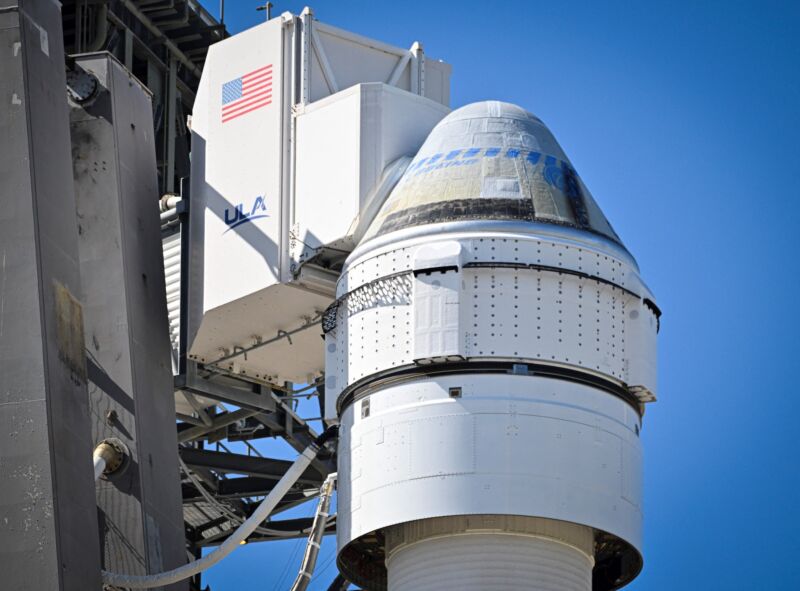
Miguel J. Rodriguez Carrillo/AFP via Getty Images
The first crewed test flight of Boeing’s long-delayed Starliner spacecraft will not lift off as planned Saturday and could be delayed longer as engineers evaluate a persistent helium leak from the capsule’s propulsion system.
NASA announced the latest delay to the Starliner test flight on Tuesday evening. Officials will take more time to consider their options on how to continue the mission after discovering the small helium leak on the spacecraft’s service module.
The space agency did not describe the options being considered, but sources said they ranged from flying the spacecraft “as is,” with a thorough understanding of the leak and confidence that it will not become no longer important in flight, until removing the capsule from its Atlas V rocket and bringing it back to a hangar for repair.
Theoretically, the first option could allow a launch attempt as early as next week. This latter alternative could delay the launch at least until the end of summer.
“The team met for two consecutive days to evaluate the flight rationale, system performance and redundancy,” NASA said in a statement Tuesday evening. “There is still work to be done in these areas, and the next possible launch opportunity is still being discussed. NASA will share more details once we have a clearer path forward.”
Delays are nothing new for the Starliner program, but it’s not yet clear how this delay will compare to the spacecraft’s previous setbacks.
Software issues interrupted an unpiloted test flight in 2019, forcing Boeing to fly a second demonstration mission. Starliner was on the launch pad when pre-flight checks revealed stuck valves in the spacecraft’s propulsion system in 2021. Boeing eventually flew Starliner on a round-trip mission to the space station in May 2022. Concerns about Starliner’s parachutes and flammable ribbon inside the spacecraft’s crew cabin delayed the crewed test flight from last summer until this year.
Boeing aims to become the second company to send astronauts to the space station under contract with NASA’s Commercial Crew Program, after SpaceX’s crew transportation service begins in 2020. Assuming a test flight crewed without issue, NASA hopes to license the Starliner spacecraft for six months. month-long crew rotation flights to the space station starting next year.
In the niche
Engineers first noticed the helium leak during the Starliner’s first crewed test flight launch attempt on May 6, but officials did not consider it significant enough to stop the launch . Ultimately, a separate problem with a pressure regulating valve on the spacecraft’s United Launch Alliance (ULA) Atlas V rocket prompted officials to cancel the launch attempt.
NASA astronauts Butch Wilmore and Suni Williams were already strapped into their seats inside the Starliner spacecraft on the launch pad of the Cape Canaveral, Fla., space station when authorities ordered the account shut down counting down to May 6. Wilmore and Williams returned home to Houston to await the next opportunity to launch the Starliner.
ULA returned the Atlas V rocket to its hangar, where technicians replaced the faulty valve in time for another launch attempt on May 17. NASA and Boeing pushed back the launch date to May 21, then to May 25, as engineers assessed the helium leak. The Atlas V rocket and Starliner spacecraft remain inside ULA’s Vertical Integration Facility awaiting the next launch opportunity.
Boeing engineers traced the leak to a flange on a single reaction control system thruster in one of the Starliner service module’s four niche-shaped propulsion pods.
There are 28 Reaction Control System thrusters – essentially small rocket engines – on the Starliner service module. In orbit, these thrusters are used for minor trajectory corrections and to steer the spacecraft in the correct direction. The service module has two sets of more powerful engines for larger orbital adjustments and launch-abort maneuvers.
The spacecraft’s propulsion system is pressurized using helium, an inert gas. The propellants burn a toxic propellant mixture of hydrazine and nitrogen tetroxide. Helium is not combustible, so a small leak is unlikely to constitute a major ground safety issue. However, the system needs enough helium gas to force the propellants from their internal storage tanks into the Starliner thrusters.
In a statement last week, NASA called the helium leak “stable” and said it would not pose a risk to the Starliner mission if it did not worsen. A Boeing spokesperson declined to provide Ars with details on the helium leak rate.
If NASA and Boeing resolve their concerns about the helium leak without requiring lengthy repairs, the International Space Station could accommodate Starliner docking until part of July. After docking at the station, Wilmore and Williams will spend at least eight days at the resort before undocking to head for a parachute and airbag assisted landing in the southwest United States.
After July, the calendar becomes complicated.
The space station has a busy roster of several visiting crews and cargo vehicles in August, including the arrival of a new team of astronauts on a SpaceX Dragon spacecraft and the departure of an outgoing crew on another Dragon. There could be an additional window for Starliner to dock with the space station in late August or early September before the launch of SpaceX’s next cargo mission, which will occupy the docking port Starliner is scheduled to use. The docking port reopens in the fall.
ULA also has other high-priority missions it would like to launch from the same platform needed for the Starliner test flight. Later this summer, ULA plans to launch the U.S. Space Force’s final mission using an Atlas V rocket. Then, ULA plans to launch the second demonstration flight of its new Vulcan Centaur rocket, which replaces the ‘Atlas V, from September.